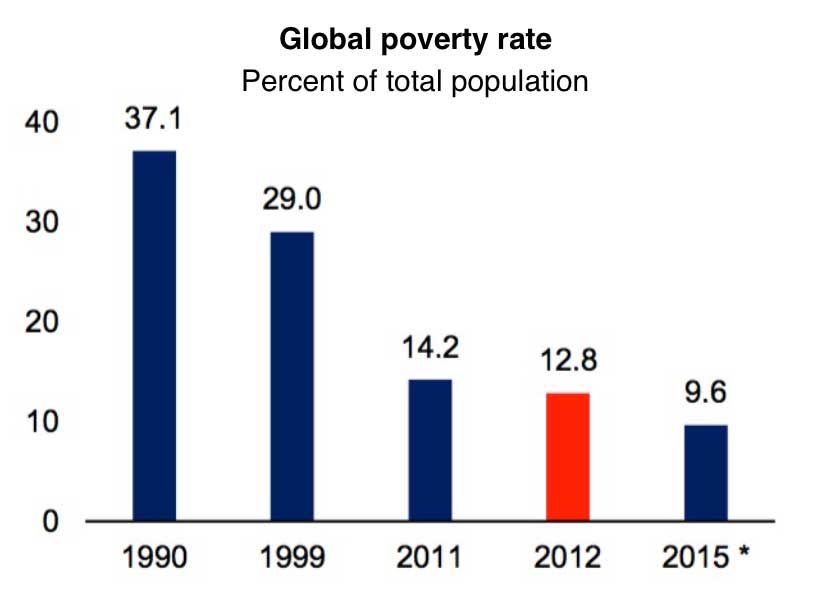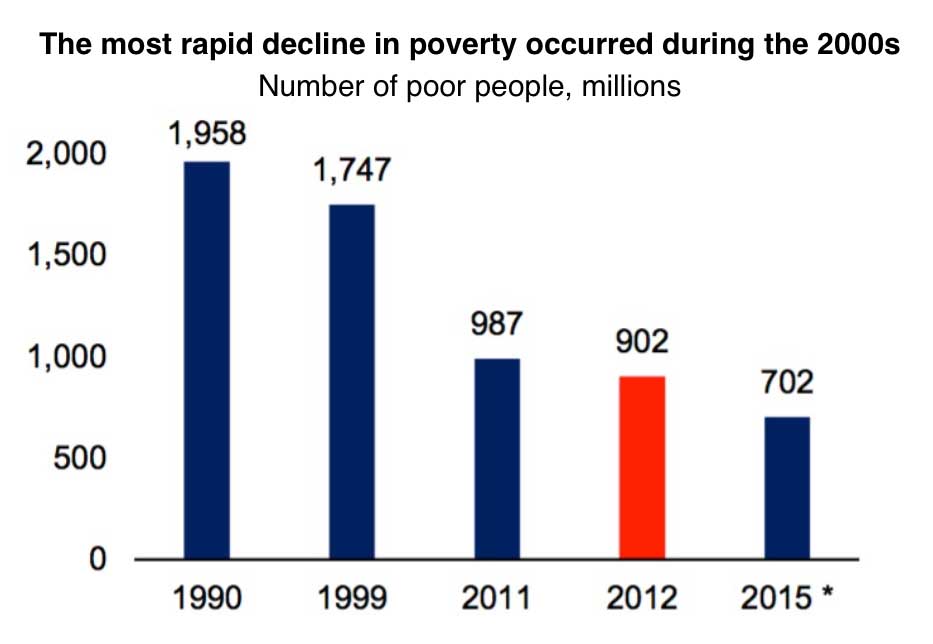I have written before about the way that a pessimistic view of the world, which has no basis in fact and is not supported by any data, has become embedded in our popular culture. In popular discourse it is taken as a given that the world is in a bad shape and getting worse. That is completely wrong. In fact if one looks at almost any metric that could be sensibly used to measure human welfare the data shows a very clear picture. Human welfare is improving, has been improving for a long time, has improved a lot in just the last few decades, and shows no sign of getting worse.
This week there was some very good news indeed but it caused few headlines.
The World Bank released a report which estimates that for the first time ever the number of people around the world living in extreme poverty will fall below 10 percent of the population.
Using an updated international poverty line of USD $1.90 a day, the Bank estimated that global poverty has fallen from 12.8 percent of the world’s population in 2012 to 9.6 percent of the global population in 2015. And its not just the rate that is falling, the total number of people living in extreme poverty is falling even though the total population is growing. The new figures raise hopes that extreme poverty could be eliminated in the near future, the bank said.
“This is the best story in the world today — these projections show us that we are the first generation in human history that can end extreme poverty,’’ Jim Yong Kim, president of the World Bank, said in a statement.
The new figures are certainly remarkable when you consider that just 25 years ago more than a third of the world was living in extreme poverty, according to the Bank’s figures. Despite the rising population all around the world, there are less than half the number of people living in extreme poverty in 2015 than there were in 1990.
The World Bank says that its new forecasts show that factors such as strong growth in developing countries and investments in people’s education, health and social safety have had a big effect on global poverty rates. “This new forecast of poverty falling into the single digits should give us new momentum and help us focus even more clearly on the most effective strategies to end extreme poverty,” Kim said.
Poverty remains concentrated in Sub-Saharan Africa and South Asia
For the last several decades, three regions, East Asia and Pacific, South Asia, and Sub-Saharan Africa, have accounted for some 95 percent of global poverty. Yet, the composition of poverty across these three regions has shifted dramatically. In 1990, East Asia accounted for half of the global poor, whereas some 15 percent lived in in Sub-Saharan Africa; by 2015 forecasts, this is almost exactly reversed: Sub-Saharan Africa accounts for half of the global poor, with some 12 percent living in East Asia. Poverty is declining in all regions but it is becoming deeper and more entrenched in countries that are either conflict ridden or overly dependent on commodity exports.
The growing concentration of global poverty in Sub-Saharan Africa is of great concern. While some African countries have seen significant successes in reducing poverty, the region as a whole lags the rest of the world in the pace of lessening poverty. Sub-Saharan poverty fell from an estimated 56 percent in 1990 to a projected 35 percent in 2015. Rapid population growth remains a key factor blunting progress in many countries—as this year’s Global Monitoring Report to be launched on October 8 shows.
In its regional forecasts for 2015, the Bank said that poverty in East Asia and the Pacific would fall to 4.1 per cent of its population, down from 7.2 per cent in 2012; Latin America and the Caribbean would fall to 5.6 per cent from 6.2 in 2012; South Asia would fall to 13.5 per cent in 2015, compared to 18.8 per cent in 2012; Sub-Saharan Africa declines to 35.2 per cent in 2015, compared to 42.6 per cent in 2012. Reliable current poverty data is not available for the Middle East and North Africa because of conflict and fragility in key countries in the region.




